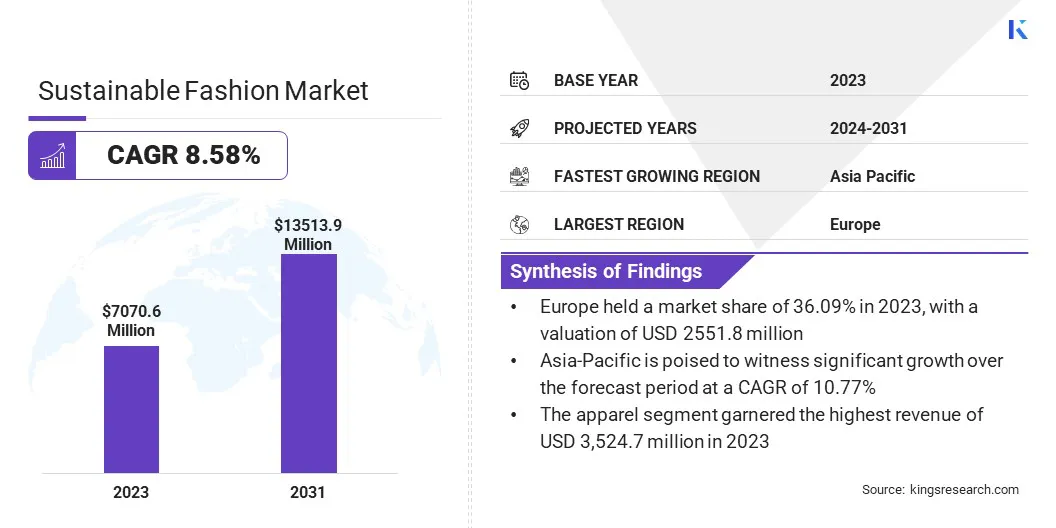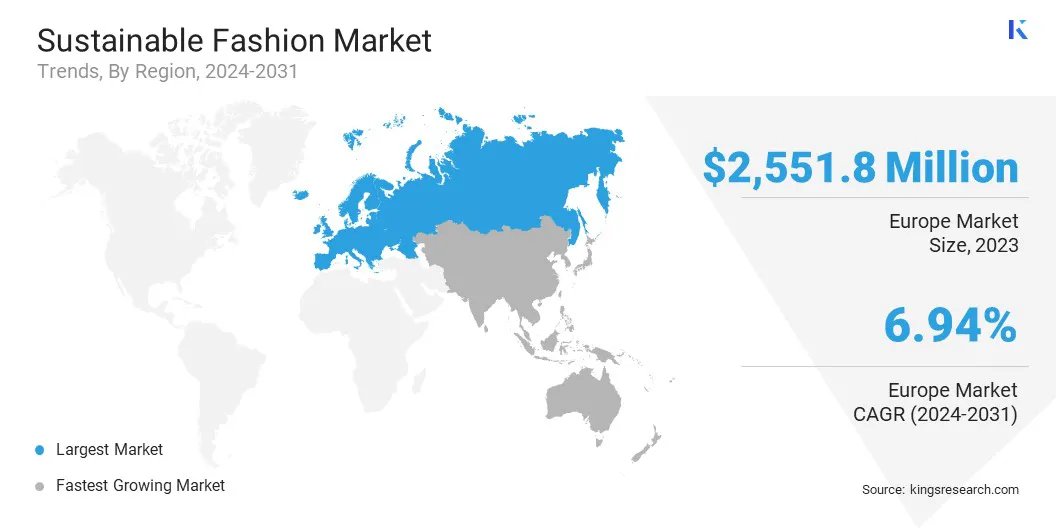Sustainable Fashion Market Size
The global Sustainable Fashion Market size was valued at USD 7,070.6 million in 2023 and is projected to reach USD 13,513.9 million by 2031, growing at a CAGR of 8.58% from 2024 to 2031. In the scope of work, the report includes solutions offered by companies such as Levi Strauss & Co, Patagonia, Stella McCartney, PACT, Tentree, Eileen Fisher's, People Tree, Amour Vert, Adidas, Reformation and Others.
The sustainable fashion market is witnessing notable growth due to rising consumer awareness regarding prevalent social and environmental issues associated with the fashion industry. This includes the growing adoption of eco-friendly clothing, accessories, and footwear, which are produced and utilized in socially and environmentally responsible ways.
The market has experienced significant expansion in recent years, with companies enhancing their product offerings to meet consumer demands for ethically sourced products. This trend is projected to drive market growth in the forthcoming years as consumers are increasingly prioritizing sustainability in their purchasing habits by favoring brands that demonstrate transparency, ethical sourcing, and other eco-friendly practices.
Numerous fashion brands, both established and startups, are entering this market, with a major focus on organic and recycled materials, sustainable production processes, and fair trade.
Companies are investing in innovations including new eco-friendly materials and technology to establish transparent supply chains to accommodate consumer demand. Challenges such as higher production costs and the limited availability of sustainable materials impact the market, highlighting the need for consumer awareness.
Governments and regulatory bodies are emphasizing sustainability in fashion, influencing companies to adopt responsible practices. Consumer behavior is shifting toward minimalism, circular fashion, and conscious consumption, resulting in brands adopting sustainable practices.
The outlook of the sustainable fashion industry appears promising, driven by rising consumer demand, innovation, and favorable regulatory changes, marking a significant shift toward ethical and responsible practices in the fashion industry.

Analyst’s Review
The sustainable fashion market continues to witness robust growth, driven by increased consumer awareness regarding environmental and social impacts. Key factors contributing to this trend include the increasing demand for eco-friendly products, industry-wide adoption of sustainable practices, and regulatory support from global governments.
Innovations in materials and production processes further fuel market expansion. Although challenges such as production costs persist, the market's growth trajectory remains positive, reflecting a fundamental shift toward more responsible fashion choices.
Sustainable Fashion Market Growth Factors
Increasing concerns regarding environmental conservation and ethical values is a key factor driving the growth of the sustainable fashion market. This rise in awareness regarding the fashion industry's environmental impact, particularly in terms of pollution and waste, significantly influences consumer behavior.
Moreover, growing empathy toward fair labor practices is fueling the demand for sustainable and ethically produced fashion items. This shift in consumer values prompts fashion brands to implement sustainable practices, including the use of eco-friendly materials, thus resulting in a reduction in the carbon footprint and ensuring transparency in supply chains. These efforts further align with the ethical and environmental concerns of their consumers.
The higher production costs associated with sustainable materials and ethical manufacturing practices are significant challenges associated with the sustainable fashion market.
Overcoming this challenge involves implementing strategies such as optimizing supply chains, investing in innovative technologies for sustainable production, and educating consumers about the value of sustainable fashion. Collaboration across the industry, including partnerships with sustainable suppliers and shared resources for research and development, helps reduce costs and makes sustainable fashion more accessible to a broader market segment.
Sustainable Fashion Market Trends
The notable shift toward a circular economy model emphasizes the importance of recycling, upcycling, and waste reduction. This trend has necessitated the implementation of circular strategies including garment rental services, resale platforms, and other closed-loop production systems to minimize environmental impact and promote resource efficiency throughout the fashion supply chain.
This trend is further driven by rising consumer demand for more sustainable and ethical fashion options, encouraging brands to adopt innovative approaches in design, production, and consumption that prioritize longevity and waste reduction.
The growing emphasis on transparency and traceability in the fashion industry is exerting a transformative influence on the market. Consumer demand for greater visibility in the supply chains, encompassing information regarding the source and methods employed to create the clothes, as well as the social and environmental impact of the production process, are major factors supporting the growth of the industry.
This is prompting manufacturers to implement transparency methods, such as the disclosure of sourcing practices, certifications, and sustainability reports, in order to build trust with consumers and demonstrate their commitment to ethical and sustainable practices. This fosters accountability, greater transparency, and responsible sourcing practices.
Segmentation Analysis
The global sustainable fashion market is segmented based on product type, fabric type, end user, distribution channel, and geography.
By Product Type
Based on product type, the market is segmented into apparel, footwear, and accessories. The apparel segment led the market in 2023, reaching a valuation of USD 3,524.7 million.
This dominance is mainly attributable to the rising consumer demand for eco-friendly options, industry-wide sustainability initiatives, coupled with technological advancements in sustainable materials, regulatory pressures, supply chain transparency efforts, and supportive circular economy initiatives. These factors collectively position apparel as the most accessible and prominent category for sustainable fashion choices, thereby driving its dominance in the market.
By Fabric Type
Based on fabric type, the market is divided into recycled fabric, organic/natural fabric, and regenerated fabric. The organic/natural fabric segment secured the largest revenue share of 40.89% in 2023 due to rising consumer preference for eco-friendly materials that offer environmental benefits such as reduced pollution and preservation of biodiversity.
Regulatory standards that promote the use of organic textiles are driving brands to innovate and improve their product lineup, thereby indicating a commitment to sustainability. Effective marketing helps enhance consumer perception regarding brands and their products. Technological advancements facilitate large-scale production, collectively increasing product demand and availability. This trends makes organic/natural fabrics an ideal choice for environmentally conscious consumers and sustainable fashion brands.
Sustainable Fashion Market Regional Analysis
Based on region, the global sustainable fashion market is classified into North America, Europe, Asia-Pacific, MEA, and Latin America.

The Europe Sustainable Fashion Market share stood around 36.09% in 2023 in the global market, with a valuation of USD 2551.8 million. Europe is dominating the sustainable fashion market mainly backed by the prioritization of eco-friendly products by European consumers.
Moreover, stringent environmental regulations in the region foster sustainable practices in the fashion industry, compelling brands to innovate and highlight their commitment to sustainability. Additionally, strong consumer awareness regarding the need for sustainability in the industry supports the initiatives by manufacturers solidifying Europe’s position in the market.
Asia-Pacific is poised to witness significant growth over the forecast period at a CAGR of 10.77%. The Asia-Pacific region is anticipated to dominate the sustainable fashion market in the forecast duration (2024-2031) due to several factors, including its large and growing population in countries such as India and China.
Rising environmental consciousness among consumers, coupled with the presence of key manufacturing hubs focused on sustainable materials and production processes, is boosting production in the region. Moreover, increasing government initiatives aimed at promoting sustainability and the surging number of innovative, socially responsible fashion brands in the region are expected to stimulate regional market growth over the forecast period.
Competitive Landscape
The global sustainable fashion market report will provide valuable insight with an emphasis on the fragmented nature of the industry. Prominent players are focusing on several key business strategies such as partnerships, mergers and acquisitions, product innovations, and joint ventures to expand their product portfolio and increase their market shares across different regions.
Other initiatives, including investments in R&D activities, the establishment of new manufacturing facilities, and supply chain optimization, could create new opportunities for market growth.
List of Key Companies in Sustainable Fashion Market
- Levi Strauss & Co
- Patagonia
- Stella McCartney
- PACT
- Tentree
- Eileen Fisher's
- People Tree
- Amour Vert
- Adidas
- Reformation
Key Industry Developments
- December 2023 (Collaboration): Andrew Burgess, a US-based upcycler, collaborated with PUMA to design five pieces using PUMA's recycled polyester RE: FIBRE fabric. The designs showcase the concept of circular fashion, demonstrating the ongoing transformation of old garments into new ones. This collaboration highlighted the significance of sustainable materials and circular practices in the fashion industry, emphasizing the need for recycling and minimizing waste in fashion production processes.
The Global Sustainable Fashion Market is Segmented as:
By Product Type
- Apparel
- Footwear
- Accessories
By Fabric Type
- Recycled Fabric
- Organic/Natural Fabric
- Regenerated Fabric
By End User
By Distribution Channel
- Brand Outlets
- Multi-brand Outlets
- Department Stores and Boutiques
- Online Retailers
By Region
- North America
- Europe
- France
- U.K.
- Spain
- Germany
- Italy
- Russia
- Rest of Europe
- Asia-Pacific
- China
- Japan
- India
- South Korea
- Rest of Asia-Pacific
- Middle East & Africa
- GCC
- North Africa
- South Africa
- Rest of Middle East & Africa
- Latin America
- Brazil
- Argentina
- Rest of Latin America


